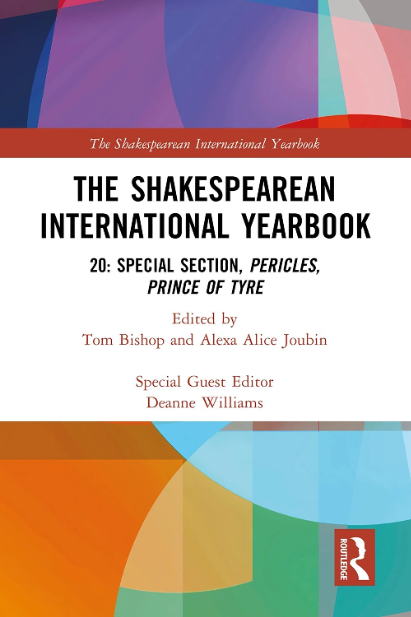The Shakespearean International Yearbook 20: Pericles, Prince of Tyre
Routledge, 2024 ::: ISBN: 9781003453314 ::: DOI: 10.4324/9781003453314
Table of Contents
Preface
Tom Bishop and Alexa Alice Joubin
Part I: Special Section: Pericles, Prince of Tyre
Special Guest Editors:
Deanne Williams, York University, and Tom Bishop, University of Auckland
- Introduction
Deanne Williams, York University, and Tom Bishop, University of Auckland
- Whose Pericles, and Why, and When?
Stephen Orgel, Stanford University
- The Excesses of Romance: Shakespeare’s Pericles and the Medieval Baroque
Robert Hudson Vincent, Harvard University
- Hrotswitha of Gandersheim, Pericles, Prince of Tyre, and Humanist Girlhood
Deanne Williams, York University
- Eater and Eaten, Feeder and Fed: Intercultural Consumption in Pericles
Stephen Cohen, Central Connecticut State University
- Pericles and the Sea of Things
Andrew S. Brown, Dalhousie University
- Pericles and the Primacy of Movement
Tonhi Lee, Tufts University
- “The purchase is to make men glorious”: Pericles on the Stuart Court Stage
Gabriel Lonsbery, Purdue University
- Inscribed Props and Daughters in Pericles
Bernice Mittertreiner Neal, York University
- Musicking the Spheres in Pericles
Jennifer Linhart Wood, George Mason University
- Pericles Comes to America
Tom Bishop, University of Auckland
- Line Dancing, Belly Dancing, and Martial Arts: Staging the Soldiers’ Dance in Pericles
Linda McJannet, Bentley University
- Productions of Pericles, Prince of Tyre, 1900-2020: a checklist
Tom Bishop, University of Auckland
Part Two: Recent Literature Review
- Intersectional Shakespeare: the State of the Field, 2020-21
Nicole A. Jacobs, California Polytechnic State University
Co-edited by Tom Bishop, Alexa Alice Joubin, and Deanne Williams, this volume focuses on Pericles, Prince of Tyre, whose narrative of refugee suffering, familial loss, emotional distancing, people-trafficking, and eventual, joyous recovery speaks strikingly to our historical moment. The play’s internationalist reach, its images of cross-cultural relations, and its Eastern Mediterranean setting also promote a reflection on the current politics of global exchange.
Notably this volume includes a comprehensive list of productions up to 2020. After an Introduction reviewing key aspects of the play’s history, the dozen contributions are grouped into four trios.
The first two trios examine Pericles’ place in the canon and its appropriation of ideas of the baroque and medievalism to the story’s relevance to the culture of early seventeenth-century England.
This sets up a strong foundation for readers to appreciate the third trio on theoretical and practical performance cues scripted within the play itself, such as its use of props, the court masque.
Essays in the fourth trio take us to performances of the play in modern times, including an in-depth analysis of its first known performance in North America in Massachusetts in 1920 and a survey of dance in twenty eight productions from 1947 to 2018, focused in particular on questions of choreography and the incorporation of international dance traditions in the soldiers’ dance at Pentapolis, where Pericles meets his future wife, Thaisa. This trio concludes with a global chronological list of known productions of Pericles.
In addition to its curated thematic section on Pericles, there is a “state of the field” review essay in keeping with the general commitment to current scholarship in international Shakespeare studies.
In this volume, we feature Nicole A. Jacobs’s “Intersectional Shakespeare” which covers new scholarship during the pandemic on social justice issues through the lenses of critical race theory, queer theory, disability studies, and studies of the non-human.
